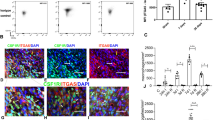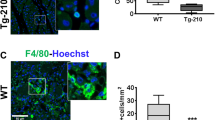Abstract
Although tissue injury and inflammation are considered essential for the induction of angiogenesis, the molecular controls of this cascade are mostly unknown. Here we show that a macrophage-derived peptide, PR39, inhibited the ubiquitin–proteasome-dependent degradation of hypoxia-inducible factor-1α protein, resulting in accelerated formation of vascular structures in vitro and increased myocardial vasculature in mice. For the latter, coronary flow studies demonstrated that PR39-induced angiogenesis resulted in the production of functional blood vessels. These findings show that PR39 and related compounds can be used as potent inductors of angiogenesis, and that selective inhibition of hypoxia-inducible factor-1α degradation may underlie the mechanism of inflammation-induced angiogenesis.
This is a preview of subscription content, access via your institution
Access options
Subscribe to this journal
Receive 12 print issues and online access
$209.00 per year
only $17.42 per issue
Buy this article
- Purchase on Springer Link
- Instant access to full article PDF
Prices may be subject to local taxes which are calculated during checkout






Similar content being viewed by others
References
Ware, J.A. & Simons, M. Angiogenesis in ischemic heart disease . Nature Med. 3, 158–164 (1997).
Arras, M. et al. Monocyte activation in angiogenesis and collateral growth in the rabbit hindlimb. J. Clin. Invest. 101, 40–50 (1998).
Arras, M. et al. Tumor necrosis factor-alpha is expressed by monocytes/macrophages following cardiac microembolization and is antagonized by cyclosporine. Basic Res. Card. 93, 97–107 (1998).
Gordon, S., Clarke, S., Greaves, D. & Doyle, A. Molecular immunobiology of macrophages: recent progress. Curr. Opin. Immunol. 7, 24–33 (1995).
Sunderkotter, C., Goebeler, M., Schulze-Osthoff, K., Bhardwaj, R. & Sorg, C. Macrophage-derived angiogenesis factors . Pharm. Ther. 51, 195– 216 (1991).
Agerberth, B. et al. Amino acid sequence of PR-39. Isolation from pig intestine of a new member of the family of proline-arginine-rich antibacterial peptides . Eur. J. Biochem. 202, 849– 54 (1991).
Gallo, R.L. et al. Syndecans, cell surface heparan sulfate proteoglycans, are induced by a proline-rich antimicrobial peptide from wounds. Proc. Natl. Acad. Sci. USA 91, 11035–11039 (1994).
Li, J., Brown, L.F., Laham, R.J., Volk, R. & Simons, M. Macrophage-dependent regulation of syndecan gene expression . Circ. Res. 81, 785–796 (1997).
Gudmundsson, G.H. et al. Structure of the gene for porcine peptide antibiotic PR-39, a cathelin gene family member: comparative mapping of the locus for the human peptide antibiotic FALL-39. Proc. Natl. Acad. Sci. USA 92, 7085–7089 (1995).
Chan, Y.R. & Gallo, R.L. PR-39, a syndecan-inducing antimicrobial peptide, binds and affects p130Cas. J. Biol. Chem. 273, 28978–28985 ( 1998).
Shi, J., Ross, C.R., Leto, T.L. & Blecha, F. PR-39, a proline-rich antibacterial peptide that inhibits phagocyte NADPH oxidase activity by binding to Src homology 3 domains of p47phox. Proc. Natl. Acad. Sci. USA 93, 6014–6018 (1996).
Carmeliet, P., et al. Role of HIF-1α in hypoxia-mediated apoptosis, cell proliferation and tumour angiogenesis. Nature 394, 485 –490( 1998); erratum 395 , 525 (1998).
Martin, C. et al. Cardiac hypertrophy in chronically anemic fetal sheep: Increased vascularization is associated with increased myocardial expression of vascular endothelial growth factor and hypoxia-inducible factor 1. Am. J. Obstet. Gynecol. 178, 527–534 (1998).
Gerber, H.P., Condorelli, F., Park, J. & Ferrara, N. Differential transcriptional regulation of the two vascular endothelial growth factor receptor genes. Flt-1, but not Flk-1/KDR, is up-regulated by hypoxia. J. Biol. Chem. 272, 23659–23667 (1997).
Salceda, S. & Caro, J. Hypoxia-inducible factor 1α (HIF-1α) protein is rapidly degraded by the ubiquitin-proteasome system under normoxic conditions. Its stabilization by hypoxia depends on redox-induced changes. J. Biol. Chem. 272, 22642–22647 (1997).
Huang, L.E., Gu, J., Schau, M. & Bunn, H.F. Regulation of hypoxia-inducible factor 1alpha is mediated by an O2- dependent degradation domain via the ubiquitin-proteasome pathway. Proc. Natl. Acad. Sci. USA 95, 7987–7992 (1998).
Kallio, P.J., Wilson, W.J., O'Brien, S., Makino, Y. & Poellinger, L. Regulation of the hypoxia-inducible transcription factor 1alpha by the ubiquitin-proteasome pathway. J. Biol. Chem. 274, 6519–6525 (1999).
Ng, W.A., Grupp, I.L., Subramaniam, A. & Robbins, J. Cardiac myosin heavy chain mRNA expression and myocardial function in the mouse heart. Circ. Res. 68, 1742– 1750 (1991).
Aird, W.C., Jahroudi, N., Weiler-Guettler, H., Rayburn, H.B. & Rosenberg, R.D. Human von Willebrand factor gene sequences target expression to a subpopulation of endothelial cells in transgenic mice. Proc. Natl. Acad. Sci. USA 92, 4567–4571 (1995).
Fenteany, G. & Schreiber, S.L. Lactacystin, proteasome function, and cell fate. J. Biol. Chem. 273, 8545– 8548 (1998).
Lee, D.H. & Goldberg, A.L. Proteasome inhibitors cause induction of heat shock proteins and trehalose, which together confer thermotolerance in Saccharomyces cerevisiae. Mol. Cell. Biol. 18, 30–38 (1998).
Bush, K.T., Goldberg, A.L. & Nigam, S.K. Proteasome inhibition leads to a heat-shock response, induction of endoplasmic reticulum chaperones, and thermotolerance. J. Biol. Chem. 272, 9086–9092 (1997).
Meriin, A.B., Gabai, V.L., Yaglom, J., Shifrin, V.I. & Sherman, M.Y. Proteasome inhibitors activate stress kinases and induce Hsp72. Diverse effects on apoptosis. J. Biol. Chem. 273, 6373–6379 (1998).
Shen, B.Q. et al. Homologous up-regulation of KDR/Flk-1 receptor expression by vascular endothelial growth factor in vitro. J. Biol. Chem. 273, 29979–29985 ( 1998).
Kroll, J. & Waltenberger, J. VEGF-A induces expression of eNOS and iNOS in endothelial cells via VEGF receptor-2 (KDR). Biochem. Biophys. Res. Commun. 252, 743– 746 (1998).
Bouloumie, A., Schini-Kerth, V.B. & Busse, R. Vascular endothelial growth factor up-regulates nitric oxide synthase expression in endothelial cells. Cardio. Res. 41, 773–780 (1999).
Bein, K. et al. c-Myb function in fibroblasts. J. Cell. Phys. 173, 319–326 (1997).
Hughes, S.E. Functional characterization of the spontaneously transformed human umbilical vein endothelial cell line ECV304: use in an in vitro model of angiogenesis . Exp. Cell. Res. 225, 171– 185 (1996).
Dhanabal, M. et al. Endostatin: yeast production, mutants, and antitumor effect in renal cell carcinoma. Cancer Res. 59, 189–197 (1999).
Passaniti, A. et al. A simple, quantitative method for assessing angiogenesis and antiangiogenic agents using reconstituted basement membrane, heparin, and fibroblast growth factor. Lab. Invest. 67, 519–528 (1992).
Guillot, P.V. et al. A vascular bed-specific pathway. J. Clin. Invest. 103, 799–805 ( 1999).
Li, J., Hampton, T., Morgan, J.P. & Simons, M. Stretch-induced VEGF expression in the heart. J. Clin. Invest. 100, 18–24 ( 1997).
Maulik, N. et al. Nitric oxide signaling in ischemic heart. Cardio. Res. 30, 593–601 ( 1995).
Sellke, F.W. et al. Angiogenesis induced by acidic fibroblast growth factor as an alternative method of revascularization for chronic myocardial ischemia . Surgery 120, 182–188 (1996).
Acknowledgements
This work was supported in part by National Institutes of Health grants R01 HL53793 and P50 HL 56993 (M.S.), HL 46716 (F.W.S.), F32 HL10013 (R.V.), American Heart Association Established Investigator Award (M.S.) and by a grant from Chiron Corporation (M.S.).
Author information
Authors and Affiliations
Corresponding author
Rights and permissions
About this article
Cite this article
Li, J., Post, M., Volk, R. et al. PR39, a peptide regulator of angiogenesis. Nat Med 6, 49–55 (2000). https://doi.org/10.1038/71527
Received:
Accepted:
Issue Date:
DOI: https://doi.org/10.1038/71527
This article is cited by
-
The effect of gum Arabic supplementation on cathelicidin expression in monocyte derived macrophages in mice
BMC Complementary Medicine and Therapies (2022)
-
Neutrophil degranulation and myocardial infarction
Cell Communication and Signaling (2022)
-
Cathelicidin-related antimicrobial peptide protects against myocardial ischemia/reperfusion injury
BMC Medicine (2019)
-
Physician-initiated clinical study of limb ulcers treated with a functional peptide, SR-0379: from discovery to a randomized, double-blind, placebo-controlled trial
npj Aging and Mechanisms of Disease (2018)
-
Hepatocytes express the antimicrobial peptide HBD-2 after multiple trauma: an experimental study in human and mice
BMC Musculoskeletal Disorders (2017)



